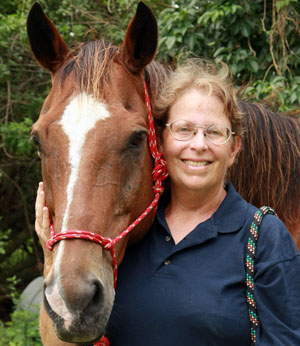TALES FROM THE TRAILS
There’s an old saying: build a better mousetrap and the world will beat a path to your door. William Micklem didn’t build a better mousetrap; he built a better bridle.
William’s father was a horse dealer, and he grew up surrounded by horses and ponies at their home in western England. As a youth in Pony Club, he competed in the national championships three times and was short-listed for both the British junior horse trials and show jumping teams.
After receiving his British Horse Society instructor’s certificate in 1973, William went to work as chief instructor for Robert Hall in both Fulmer, England, and Pepperell, Mass., which is when he began his long association with Karen O’Connor. Three years later, he moved to Ireland.
In 1987, he became training director at the Gleneagles Mark Phillips Equestrian Centre in Scotland. He is currently based at his Annacrivey Stud in County Wicklow, Ireland. Earlier this year, William was honored by Eventing Nation with a lifetime achievement award for his work as a coach, writer, speaker, breeder and inventor.
William spoke to an enthusiastic group at the Wellington Club during the March 13 Lunch & Learn series during the Winter Equestrian Festival. Hosted by Horseware Ireland and entitled “Developing Products with a Purpose,” William detailed his background. He gave away an autographed copy of his book, The Complete Horse Riding Manual, as well as one of his bridles. Oddly enough, the same young girl won them both!
His unique Micklem bridle is designed from the inside out, contoured to fit the horse’s skull, avoiding pressure on the facial nerves, projecting cheek bones and upper molars.
William held up a horse’s skull and explained that since the top jaw is considerably wider than the lower, the inside of the cheeks are often squashed, bruised and lacerated between the outer edge of the upper jaw teeth on one side and the noseband pressing inward on the other. Traditional bridles can also exert pressure on the delicate, fragile bones at the end of the nose and on the poll, the top of the head.
William’s bridle has a wider crown, which is shaped and padded, and a noseband that sets a little higher than traditional cavessons and then swoops down below the bit to act as a dropped noseband. It provides a great solution for horses that don’t like going on the bit because of pain, or hate the pressure and resist taking up a contact.
Developing the bridle took William 20 years of trial and error, although he had the basic design done in about a year. He sent it out to riders in various disciplines to use in real-life situations, tweaking and redesigning it according to their feedback. One of those riders was Marcia Kulak, who also attended the March 13 Lunch & Learn session.
A top three-day event rider and trainer based in New York and Wellington, Marcia has successfully competed in numerous international competitions and has been short-listed for two Olympic Games. She trains jumpers and hunters, as well as top eventers.
“I was with Karen and David O’Connor in Ireland,” she recalled. “We were looking to buy some horses, and William was the agent we used. I became good friends with him and kept in touch. Ten years ago, he sent me one of the prototypes of his Micklem bridle and asked me to use it and tell him what I thought.”
Marcia was a logical choice, since she could use it in a variety of disciplines — dressage, eventing and jumping — and give feedback.
“I used it on every horse in the barn, eight to 10 horses in all stages of training, and found that they universally liked it,” she said. “They all went better in the mouth, flexed more easily and were more willing to come on the bit. They seemed very responsive to it, no matter what bit I used with it. They all very quickly became accustomed to it. They were comfortable going in it from day one.”
Her horses weren’t the only fans.
“I liked it as well, and was really attracted to the fact that it’s built to be anatomically compatible with the horse’s skull,” Marcia said. “My vet and equine dentist were also impressed. This bridle eliminated all the pressure on a horse’s sensitive spots and soft tissue. It took less work for me to get the job done. The basic design is exceptional.”
Although accepted in the jumper ring and by the FEI for dressage competitions, the Micklem bridle is currently not allowed in hunter classes. “Because of this, I ride and train my hunters in a Micklem, then switch to a traditional bridle to show in,” Marcia sighed.
The Micklem bridle is available from Dover Saddlery in a variety of styles, including Deluxe Competition, Diamante Competition and Rambo Multibridle, which comes with a ring attached to the front of the noseband, making it easy to lunge a horse and then ride it without having to use a lunging cavesson.
“I highly recommend the Micklem bridle to anyone,” Marcia said. “It’s terrific with any bit, and you can also use it as a bitless bridle. I hope everyone will be open-minded and give it a try. I’ll even be happy to lend them one for a trial ride.”
You can view Dover’s Micklem bridles at www.doversaddlery.com, and you can contact Marcie through her web site at www.kulakequestrian.com. Learn more about Micklem at www.williammicklem.com.







